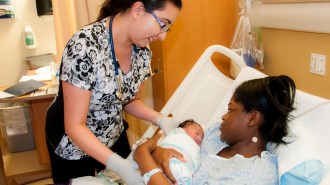A Cold Observation about Wine (with recipe)
Show this story to your boss, and she might just offer you a glass or two of wine. After all, downing this beverage–especially the red varieties–appears to help ward off the common cold, according to a new study.


Though colds usually arent dire, they remain one of the leading causes of missed days at work. In the United States alone, some 30 million days of sick leave trace to workers suffering from these viral infections–and the sneezing, stuffy heads, runny noses, hacking coughs, sore throats, and malaise that typically accompany them.
The new study was conducted in Spain, where for 1 year researchers followed the respiratory condition of almost 4,300 faculty and staff at several universities. The scientists started by surveying the participants health, their average weekly consumption of alcoholic beverages, and a host of other factors that might influence susceptibility to colds–such as stress, vitamin intake, smoking, and frequent proximity to small children.
Those who initially had a cold or suffered from asthma or some other chronic respiratory disease were culled from the study. The remaining recruits received follow-up surveys by mail every 10 weeks asking about any cold symptoms that persisted 3 or more days. In the May 1 American Journal of Epidemiology, Bahi Takkouche of the University of Santiago de Compostela, Spain, and his colleagues report that some 1,350 of the participants eventually developed at least one cold.
Overall, his group found no correlation between the incidence of these infections and the consumption of either beer or spirits. Nor did vitamin C or zinc consumption appear to affect cold susceptibility. Wine, however, came up as clearly protective.
Compared to teetotalers, men and women who downed an average of more than 2 glasses of wine daily had a 40 percent reduction in their risk of developing a cold. Among those who downed red wine exclusively, it took just 8 to 14 glasses a week to achieve this apparent benefit. But if these red aficionados quaffed more, their risk of developing a cold dropped to 60 percent below that of people who avoided alcohol, who drank beer, or who chose distilled spirits.
Why wine?
The apparent benefit of wine consumption remained even after accounting for the individuals intake of other alcoholic beverages, whether they smoked, and other known risk factors for colds.
The findings were unexpected, observes Miguel A. Hernn of the Harvard School of Public Health in Boston, a coauthor of the study. Because alcohol tends to suppress immunity, he notes, “our hypothesis was that alcohol drinking would make people more likely to become infected with the common cold.” Instead, the researchers identified no such risk.
Because the benefit is linked just to wine, the team came to the conclusion “that it is not the alcohol in the red wine, but some other component, that is protective. So, we started to look at other compounds that are mainly in wine–especially red wines,” Hernn told Science News Online.
Numerous studies of other illnesses have turned up evidence that wine may confer–when taken in moderation–long-term benefits, especially in diabetics (SN: 7/24/99, p. 52) and people at risk of heart disease (Red wine: Why it’s heart-ier than white: http://www.sciencenews.org/sn_arc98/8_22_98/food.htm).
Resveratrol is one chemical prevalent in wines and grape juice that may enhance health. Research has demonstrated that it fights processes that foster heart disease–and cancer, at least in animals. In their new report, the scientists cite work by others indicating that this plant compound has strong anti-inflammatory properties. How or why it might help the body fight an infection, however, remains a mystery.
Moreover, in a review of wines benefits in heart disease, chemist Andrew L. Waterhouse of the University of California, Davis Department of Viticulture and Enology argues that even if people consume a half-liter of wine, “the likelihood that resveratrol from wine would have a physiological effect on a wine-drinking population appears to be low.”
Flavonoids are more likely to exhibit some notable effect, Waterhouse says. Members of this family of chemicals occur in most wines in higher quantities than resveratrol and have a host of beneficial attributes–at least in test-tube and rodent studies. Indeed, Takkouches team points to experiments indicating that some flavonoids fight viruses by interfering with their DNA synthesis.
Refining the take-home message
The new study falls far short of proving that wine wards off infections. But if future research confirms wines protection against colds, a prophylactic evening glass or two of merlot might prove a special boon to the workforces busiest bees.
Earlier this year, Takkouches group reported that the people who rated their lives the most stressful succumbed to twice as many colds as did those claiming not to be stressed. People who felt especially upbeat, on the other hand, appeared less vulnerable than average. Indeed, this positive mental attitude appeared equally protective against colds as drinking two glasses of wine daily.
However, Takkouche, who describes himself as “almost a teetotaler,” emphasizes that his groups new findings should not be read as a license to overindulge. In fact, he acknowledges, in the beginning, “we were a little embarrassed about our results.”
Even if wine proves good for the common cold, intemperate use can fuel physical violence and traffic accidents. Whats more, he adds, “alcoholism among youngsters has become a real problem.”
While his group concluded that it would be “unethical” not to publish their data, “we have also been very concerned about how people will interpret the findings,” Takkouche observes.
Núrias Catalan Sangria
In honor of these studies and Spain, where they were conducted, we provide a recipe for a summery beverage that may offer a nutritional double whammy. It includes wine and fruits rich in vitamins and minerals. It was prepared many times for me by Núria Pérez Traver, the daughter of a chef in Barcelona, during that happy year she came to the United States to share her culture with my young family.
2 liters of red wine (any house red will do)
1 12-oz. can of frozen lemonade
8 oz. of pineapple chunks
2 peaches or nectarine cut into chunks
2 pears cut into chunks
2 bananas cut into chunks
2 large oranges, cut into thin slices
juice squeezed from two more oranges
1 lemon cut into thin slices
cinnamon to taste
optional garnish: lemon peel
Mix the ingredients together in a large jar or pitcher and let the flavors meld at least 3 hours at room temperature or overnight in the fridge. Serve with a spoon for all those fruity chunks.
“Sangria needs to be served very cold,” Núria emphasizes. And for “a touch of glamour,” she says, “put a long thin curl of a lemons peel into the glass, leaving a little hanging over the top.”







